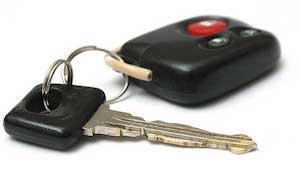Vehicle Security Under Lock and Key
If you have ever been locked out of your own car, you know that awful feeling of helplessness. That is the moment you hope you have your cellphone and AAA card handy or someone at home nearby with a separate set of keys. Only slightly worse are those days when you are in a hurry and can't recall where you left the car keys.

At the same time, car theft is rampant in all of the major metro centers in California - Los Angeles, San Francisco Bay Area, San Diego, Fresno - so no one wants to leave an unlocked car parked for long.
Increasingly, car makers choose to err on the side of security. Strong locks are deemed an essential safety feature for any car owner, and about twenty years ago manufacturers started responding to consumer concern.
The evolution of locks is moving forward rapidly in the digital age. The biggest change came when manufacturers moved from away the flat metal "Yale" key, named for American inventor Linus Yale, that had been used in pin-tumbler locks since the 1800s. Raised notches along the key blade matched cylindrical pins of pre-set heights in the corresponding lock. The downside was they were subject to lock-picking by professional thieves. The upside was that the car owner could get an inexpensive duplicate cut at the local hardware store.
In the 1980's car manufacturers began to experiment with a new form of security device using a fob. "Keyless entry" caught on quickly. Fobs use a radio wave to signal a car lock remotely. In the early years of this technology, the remote might open multiple cars. Not so secure, after all, it appeared. Now, however, the key fobs regenerate a new code each time the remote button is pushed, to avoid opening a stranger's car by mistake. There are about a trillion codes in the system, and it is unlikely two fobs would use the same code at the seam time, much less likely in the same parking lot.
The fobs run on a battery, which needs to be replaced periodically. And that is not cheap. More seriously, if you lose your key, a replacement can be hundreds of dollars. Some manufacturers have a limit to the number of key fobs that can be made for one car. If you buy a used car, make sure you get an extra, working fob, and know how - and how many - duplicates can still be made.
Car makers continue to invest time and money experimenting with the age-old problem of locks, keys and thieves. In the future, we may see key cards, fingerprints, key cryptography and devices not yet imagined. Some new makes and models, such as the Tesla, have a handy automatic system. The car locks itself when you close the door or trunk. This is great, unless you left the keys inside by mistake or forgot to tell the parking valet about that particularly clever feature.
The hardest part for car makers will be overcoming human error. For the foreseeable future, we will still have to remember where we left the keys at home, make sure we have the key in hand before slamming the door.
 Kemnitzer Barron & Krieg Home
Kemnitzer Barron & Krieg Home

